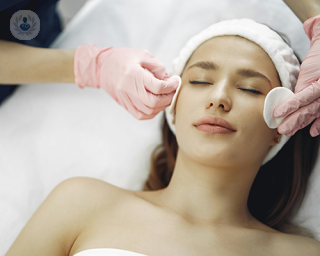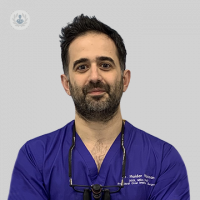What is facial aesthetics?
The natural ageing process, lifestyle factors and the environment all contribute to unwanted wrinkles, fine lines, age spots and uneven skin tones.
Facial aesthetics, otherwise known as facial rejuvenation treatments is the term used to describe non-surgical procedures that reduce the signs of ageing on the face.

Why would someone need facial aesthetic treatments?
Facial aesthetic treatments are used to give people a more youthful and radiant appearance. These treatments can soften wrinkles, contour the face and define certain facial features.
What does facial aesthetics involve?
There are several facial aesthetic treatments to reduce ageing and enhance facial features.
Some of which include:
- Wrinkle reduction
Wrinkle reduction involves injecting a natural substance derived from a micro-organism which relaxes muscles and reduces the appearance of fine lines and wrinkles, like frown lines that appear between the eyes, crow’s feet and forehead lines.
- Dermal fillers
Dermal fillers offer a safe and natural cosmetic treatment to restore volume and fullness to the skin and improve the skin’s appearance. This is ideal for deeper lines and wrinkles. Fillers can also be used to improve the definition of facial features like the lips and cheeks so that they appear fuller.
- Injectable moisturisers
Injectable moisturisers are solutions, generally made of hyaluronic acid, that are injected beneath the surface of the skin. Working from the inside out, injectable moisturisers remodel the appearance of the skin by providing intense hydration, improving elasticity and texture, and boosting luminosity. The result is plumper, softer and radiant-looking skin.
The most common facial aesthetic treatment with injectable moisturisers is Profhilo.
- Automated percutaneous collagen induction therapy (PCI)
PCI or microneedling is a procedure where small, sterile needles perforate the upper and mid-layers of the skin causing micro-trauma. The needle prick wounds induce a healing process that stimulates skin cells to produce new collagen and skin cells. Results are immediate and natural, with two or three sessions normally being required to achieve the desired result.
- Platelet-rich concentrate (PRC)
PRC is a natural healing serum that we carry in our blood. By isolating PRC from our blood, we can use this to stimulate skin cells to produce collagen and elastin to give us more youthful skin.
Combining PCI and PRC therapies works well and these treatments are non-invasive and natural, eliminating the risk of an allergic reaction to man-made treatments. These treatments do, however, require a series of sessions, spaced out over several weeks.
How do I prepare for facial aesthetics?
Before any aesthetic procedure, your doctor will talk to you about your medical history, discuss your concerns and assess your skin and skincare regime. They will then suggest the most suitable treatments for you and develop a treatment plan from there.
Some treatments are not suitable for pregnant or breastfeeding women.
What does post-operative care look like?
Post-operative care depends on the procedure undertaken but in comparison to surgical procedures for facial rejuvenation, such as a facelift, recovery time is much faster. Usually, patients can return to normal activity on the same day or the day after the procedure.
Possible side effects to wrinkle reduction treatments might include pain and tenderness around the injection site, headaches, flu-like symptoms, a droopy eyelid or a crooked smile. If symptoms persist for a long period, revisit your doctor for a check-up.
08-22-2019 11-08-2023Facial aesthetics
What is facial aesthetics?
The natural ageing process, lifestyle factors and the environment all contribute to unwanted wrinkles, fine lines, age spots and uneven skin tones.
Facial aesthetics, otherwise known as facial rejuvenation treatments is the term used to describe non-surgical procedures that reduce the signs of ageing on the face.

Why would someone need facial aesthetic treatments?
Facial aesthetic treatments are used to give people a more youthful and radiant appearance. These treatments can soften wrinkles, contour the face and define certain facial features.
What does facial aesthetics involve?
There are several facial aesthetic treatments to reduce ageing and enhance facial features.
Some of which include:
- Wrinkle reduction
Wrinkle reduction involves injecting a natural substance derived from a micro-organism which relaxes muscles and reduces the appearance of fine lines and wrinkles, like frown lines that appear between the eyes, crow’s feet and forehead lines.
- Dermal fillers
Dermal fillers offer a safe and natural cosmetic treatment to restore volume and fullness to the skin and improve the skin’s appearance. This is ideal for deeper lines and wrinkles. Fillers can also be used to improve the definition of facial features like the lips and cheeks so that they appear fuller.
- Injectable moisturisers
Injectable moisturisers are solutions, generally made of hyaluronic acid, that are injected beneath the surface of the skin. Working from the inside out, injectable moisturisers remodel the appearance of the skin by providing intense hydration, improving elasticity and texture, and boosting luminosity. The result is plumper, softer and radiant-looking skin.
The most common facial aesthetic treatment with injectable moisturisers is Profhilo.
- Automated percutaneous collagen induction therapy (PCI)
PCI or microneedling is a procedure where small, sterile needles perforate the upper and mid-layers of the skin causing micro-trauma. The needle prick wounds induce a healing process that stimulates skin cells to produce new collagen and skin cells. Results are immediate and natural, with two or three sessions normally being required to achieve the desired result.
- Platelet-rich concentrate (PRC)
PRC is a natural healing serum that we carry in our blood. By isolating PRC from our blood, we can use this to stimulate skin cells to produce collagen and elastin to give us more youthful skin.
Combining PCI and PRC therapies works well and these treatments are non-invasive and natural, eliminating the risk of an allergic reaction to man-made treatments. These treatments do, however, require a series of sessions, spaced out over several weeks.
How do I prepare for facial aesthetics?
Before any aesthetic procedure, your doctor will talk to you about your medical history, discuss your concerns and assess your skin and skincare regime. They will then suggest the most suitable treatments for you and develop a treatment plan from there.
Some treatments are not suitable for pregnant or breastfeeding women.
What does post-operative care look like?
Post-operative care depends on the procedure undertaken but in comparison to surgical procedures for facial rejuvenation, such as a facelift, recovery time is much faster. Usually, patients can return to normal activity on the same day or the day after the procedure.
Possible side effects to wrinkle reduction treatments might include pain and tenderness around the injection site, headaches, flu-like symptoms, a droopy eyelid or a crooked smile. If symptoms persist for a long period, revisit your doctor for a check-up.


What are the advantages of NeoGen Plasma treatment?
By Dr Raj Thethi
2024-12-21
NeoGen Plasma treatment is a cutting-edge technology in aesthetic medicine, offering a range of benefits for skin rejuvenation and enhancement. This non-surgical procedure uses plasma energy to stimulate the skin's natural regeneration process, leading to significant improvements in skin texture, tone and overall appearance. Here to provide a detailed look at what makes NeoGen Plasma an attractive treatment is leading facial aesthetician and medical director of Yorkshire Skin Centre, Dr Raj Thethi. See more


Chin and cheek implants: are they right for me?
By Mr Timothy Mellor
2024-12-21
We spoke to leading facial plastic surgeon, Mr Timothy Mellor, to find out about cheek implants, when they are used and what happens during facial implant surgery. Discover how this procedure We works, what the duration period is and how long the recovery time takes. See more


What are the different types of cosmetic dentistry?
By Dr Olurotimi Adesanya MBE
2024-12-21
If you are looking for a boost of confidence to your smile but feel confused or overwhelmed by all the cosmetic treatments to choose from, this article may be able to help you make your mind up. Dr Olurotimi Adesanya has put together this quick guide of the different types of cosmetic treatments available. See more


Carbon laser peels: Discover the benefits for skin enhancement
By Dr Tracy Xu
2024-12-20
In the quest for radiant and flawless skin, many people are turning to innovative and effective treatments that offer impressive results with minimal downtime. One such treatment gaining widespread popularity is the carbon laser peel. Here, Dr Tracy Xu, renowned aesthetic medicine specialist, explores the benefits, process, and considerations of carbon laser peels. See more
Experts in Facial aesthetics
-
Dr Haidar Hassan
DentistryExpert in:
- Oral surgery
- Dental implants
- Bone reconstruction
- Facial aesthetics
- Wisdom teeth
- Botulinum toxin (Botox™)
-
Dr Peter McQuillan
DentistryExpert in:
- Cosmetic dentistry (aesthetic dentistry)
- Invisalign
- Veneers
- Facial aesthetics
- Composite veneers
- Teeth whitening
-
Dr Aneka Khaira
DentistryExpert in:
- Veneers
- Invisalign
- Damon braces
- Composite veneers
- Facial aesthetics
- Teeth whitening
-
Dr Natasha Panesar
DentistryExpert in:
- Cosmetic dentistry (aesthetic dentistry)
- Smile design
- Veneers
- Composite veneers
- Invisalign
- Facial aesthetics
-
Dr Rejin Khafaf
DentistryExpert in:
- Cosmetic dentistry (aesthetic dentistry)
- Invisalign
- Dental implants
- Composite veneers
- Teeth whitening
- Facial aesthetics
- See all

The Portland Hospital - part of HCA Healthcare
The Portland Hospital - part of HCA Healthcare
205 - 209 Great Portland St. W1W 5AH
No existe teléfono en el centro.
By using the telephone number provided by TOP DOCTORS, you automatically agree to let us use your phone number for statistical and commercial purposes. For further information, read our Privacy Policy
Top Doctors

The London Dermatology Centre
The London Dermatology Centre
69 Wimpole Street, London, W1G 8AS
No existe teléfono en el centro.
By using the telephone number provided by TOP DOCTORS, you automatically agree to let us use your phone number for statistical and commercial purposes. For further information, read our Privacy Policy
Top Doctors

TKC - The Kensington Clinic
TKC - The Kensington Clinic
6 Russell Gardens, Kensington
No existe teléfono en el centro.
By using the telephone number provided by TOP DOCTORS, you automatically agree to let us use your phone number for statistical and commercial purposes. For further information, read our Privacy Policy
Top Doctors
-
The Portland Hospital - part of HCA Healthcare
205 - 209 Great Portland St. W1W 5AH, Central LondonExpert in:
- Neurological spinal surgery
- Orthopaedic spinal surgery
- Maternity care
- Pregnancy
- Scoliosis
- In vitro fertilisation (IVF)
-
The London Dermatology Centre
69 Wimpole Street, London, W1G 8AS, W1G Marylebone LondonExpert in:
- Skin Cancer
- Dermatology
- Clinical Dermatology
- Cosmetic Dermatology
- Surgical Dermatology
-
TKC - The Kensington Clinic
6 Russell Gardens, Kensington, Central LondonExpert in:
- Aesthetic Dentistry
- Dental Implants (replacing teeth)
- Dentistry
- Cosmetic dentistry
- Orthodontics
- Periodontics (gum problems)
- Most viewed diseases, medical tests, and treatments
- Chronic headache
- Visual impairment
- Diabetic retinopathy
- Retina
- Visual stress (Meares-Irlen syndrome)
- Presbyopia
- Nystagmus
- Myopia
- Hyperopia (farsightedness)
- Eye examination








